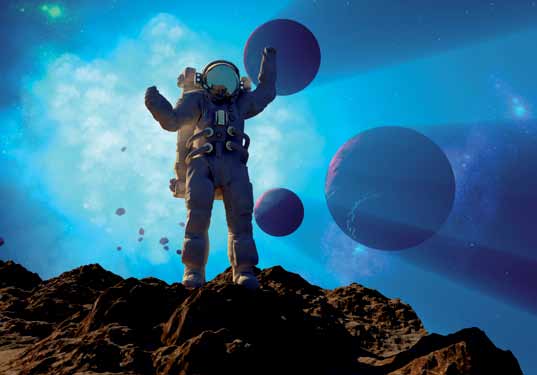Our writer examines the continuing fascination of outer space for mankind.
Perhaps the most salient fact about space is that, the longer humanity looks at it, the larger it becomes. For much of our history, it was a mere curtain in the sky, but we learned to make use of our observations. In Africa’s Rift Valley, early humans noticed the regularity of the Sun’s rise and fall and later used this knowledge to introduce farming. This also explains why humanity didn’t originate in Belgium; the first recorded sighting of the sun in our fair land was only in 911 AD.
BIG BANG
They say that if you can explain quantum mechanics, you don’t understand it
Since then, our collective curiosity has led us to a fantastic series of discoveries that has not only challenged us, but our religious beliefs, which were also a product of our looking at the stars and wondering about our place in the cosmos. We can now look at the first micro-seconds of the ‘big bang’ and in the depths of space, see its echoes and the formation of the first stars. The theoreticians are also on the verge of some astounding discoveries. They say that if you can explain quantum mechanics, you don’t understand it, then there’s string theory and the idea of multiverses, where we are in one of an infinite number of universes, some only an atom away in other dimensions.
On that scale, the ‘big bang’ itself becomes an utterly insignificant event.
MADE OF STARS
Then we get onto what occupies space, which turns out to be the atom, which comprises 99.9999999999999% nothing. Everything we see, including ourselves, is basically nothing.
None of this will likely come as news to Together readers, but when faced with the scope of the universe, we can feel confused, bemused, perhaps fearful, but above all else, we should feel wonder. We should also feel some sense of achievement.
It was in December 1903 that the Wright brothers made the first powered flight, which reached an altitude of 10 metres and lasted 12 seconds. A mere sixty six years later, the heroic and reticent Neil Armstrong invented moonwalking.
Those of us around back then witnessed the space race, which was decisively won when the Apollo crews not only played golf on the Moon but got around in the Lunar Rover, the ultimate off-road vehicle. Although it felt like we were at the beginning of another age of discovery, it didn’t happen as we thought.
The big change was moving away from astronaut-led exploration to the use of probes and robots
The proposed moonbase was never built, we stopped visiting and cancelled plans to land on Mars. The big change was moving away from astronaut-led exploration to the use of probes and robots. While we lost the tough young fliers who personalized the missions, the robots went where man could not. It is extraordinary to look back on the range of probes, satellites and landings. So far, we’ve made successful landings on Venus, Mars and have orbited a host of celestial objects, from the moons of Saturn and Jupiter, to comets and more.
LONG VOYAGE
Currently, Voyager 1 is some 10,843 million miles away, travelling beyond the solar system, at 17km per second. It is expected to keep transmitting data back to Earth – a journey that takes more 16 hours at light speed – until 2025, when the power will run out. Then it will continue its journey, in silence, forever. Closer to home, the International Space Station’s orbit passes over Belgium most days, either at around 7h or 22h, and is usually bright enough to see with the naked eye. With my phone, I downloaded a couple of apps that allow me to track it, including one with which I wave my phone at the night sky and it tells me exactly where the station is.
And when the sky is clear, it appears like a plane but without blinking lights, and it crosses the sky until suddenly vanishing as it enters the Earth’s shadow. It is a beautiful sight, even more so when we realise that, inside, scientists are not only looking at space, but also examining the Earth.
Sure, it’s expensive and we’re in an age of austerity, but I’m glad we’re doing it. Humanity is at its best when it looks outwards, when it tries to look further and to understand what lies beyond. It’s what we are, it’s what we do.
http://spaceflight.nasa.gov/station







